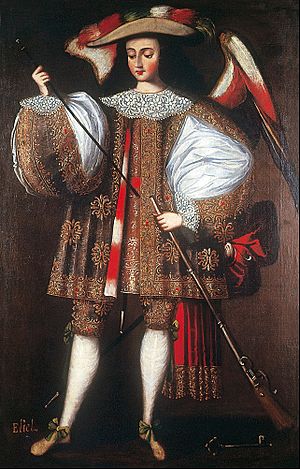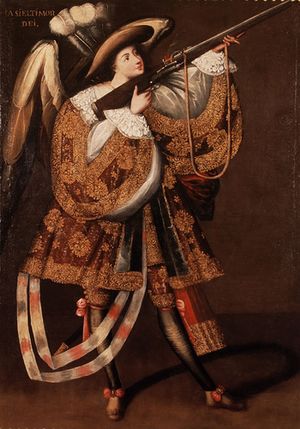Ángel arcabucero facts for kids

An Ángel arcabucero (which means 'arquebusier angel' in Spanish) is a painting or sculpture of an angel. These angels are special because they hold an arquebus (an old type of gun) instead of a sword. They also wear fancy clothes, like those worn by important people in the Andes mountains long ago. This unique art style started in Peru in the late 1600s. It became very popular, especially with the Cusco School of artists.
Contents
What Are Arquebusier Angels?
These angels are shown holding an arquebus, which was an early type of gun. Usually, angels who fight are shown with swords. But these angels carry guns, making them look like soldiers from that time. They also wear very detailed and colorful clothes. These outfits were inspired by the fancy clothing of important people in the Andes region.
Where Did This Art Style Come From?
This special art style began in Peru in the second half of the 1600s. It was very popular with artists from the Cusco School. Some experts believe these angels reminded local people of their own ancient gods and heroes who were often shown as winged warriors. This might be why the paintings were so well-liked by the native people.
The idea for these angels might have come from European pictures. Some old Spanish and Dutch engravings showed angels with guns. These pictures were sometimes based on stories not officially approved by the Church. However, these ideas still found their way into art in the Andes. The way the angels stand, like soldiers, might have come from a book of military exercises published in 1607.
Famous Examples and Locations
One of the best places to see a full collection of ángeles arcabuceros is the Church of Calamarca. This church is about 60 kilometers from La Paz, Bolivia. Here, you can find the famous Asiel Timor Dei painting, created around 1680. It is considered a great example of this art style.
In the early 1700s, many people wanted these paintings. Artists in Cusco made hundreds of them. They were sent to cities like Lima, and other places in Bolivia, Chile, and northern Argentina. To meet this high demand, large art workshops were set up. Many of these workshops were run by native artists.
Today, you can find these colonial paintings in many places. They are in churches and museums in Peru, Bolivia, and northern Argentina. You can also see them in museums in Mexico, Spain, and even the New Orleans Museum of Art in the USA. There is a special collection of ten ángeles arcabuceros in the San Francisco de Padua Church in Uquía, Argentina.
Some beautiful sculptures of ángeles arcabuceros were also made in the 1600s in Potosí. These sculptures were very detailed and colorful.
See also
 In Spanish: Ángeles arcabuceros para niños
In Spanish: Ángeles arcabuceros para niños
- Cusco School
- Sopó Archangels
- Latin American art
Images for kids



